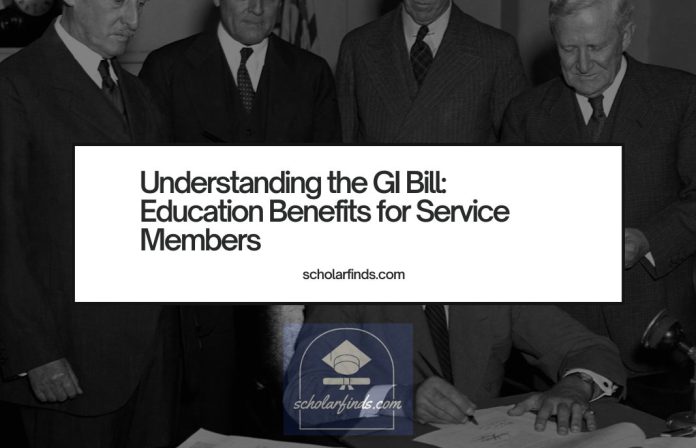Introduction
Understanding the GI Bill: Education Benefits for Service Members – The GI Bill is one of the most significant benefits available to U.S. military service members and veterans, providing substantial financial assistance for education and training. Whether you’re looking to attend college, complete a vocational program, or pursue further education, the GI Bill can help you achieve your academic and career goals without the burden of student debt. This guide will break down the key features of the GI Bill, explain how to use it, and help you understand the benefits available to you as a service member or veteran.
What is the GI Bill?
The GI Bill is a series of education benefits programs designed to help service members, veterans, and their families pay for college, graduate school, and training programs. Originally created in 1944, the GI Bill has been updated and expanded over the years, with the Post-9/11 GI Bill being the most current version.
- Post-9/11 GI Bill: The most widely used GI Bill, offering extensive benefits to service members who served on active duty after September 10, 2001.
- Montgomery GI Bill (MGIB): Another version of the GI Bill, primarily for service members who entered active duty before the implementation of the Post-9/11 GI Bill.
- Forever GI Bill: An enhancement of the Post-9/11 GI Bill that eliminates the 15-year time limit for using benefits and expands eligibility for certain types of education.
Key Benefits of the Post-9/11 GI Bill
The Post-9/11 GI Bill provides a range of benefits that can cover the cost of education, housing, and other related expenses. Here’s what you can expect:
1. Tuition and Fees
The GI Bill covers up to 100% of in-state tuition and fees at public institutions for eligible veterans. For private or foreign schools, the GI Bill provides up to a set maximum amount per academic year.
- Public Schools: Full coverage of in-state tuition and fees.
- Private Schools: Up to $27,120.05 per academic year (as of 2024).
2. Monthly Housing Allowance (MHA)
The Monthly Housing Allowance is based on the Basic Allowance for Housing (BAH) for an E-5 with dependents. The amount you receive depends on the location of your school and whether you are attending full-time or part-time.
- On-Campus: Full BAH rate for the school’s location.
- Online Classes: Half of the national average BAH rate.
3. Books and Supplies Stipend
The GI Bill provides a stipend of up to $1,000 per year to help cover the cost of books, supplies, and other educational materials.
- Annual Limit: $1,000, distributed based on the number of credits you are taking.
4. Yellow Ribbon Program
For veterans attending private or out-of-state schools where tuition may exceed the GI Bill’s maximum coverage, the Yellow Ribbon Program allows institutions to voluntarily cover the difference. The VA matches the amount the school contributes, reducing or eliminating out-of-pocket costs.
- Eligibility: Available to veterans who are eligible for the maximum benefit rate (100%).
- Participating Schools: Over 2,000 colleges and universities participate in the Yellow Ribbon Program.
5. Transfer of Benefits
The Post-9/11 GI Bill allows service members to transfer unused education benefits to their spouse or dependent children. This is an incredible benefit for families, enabling them to share the educational advantages earned through military service.
- Eligibility: Must have served at least six years in the military and agree to serve an additional four years.
How to Apply for GI Bill Benefits
Applying for GI Bill benefits is a straightforward process, but it requires gathering the necessary documentation and understanding your eligibility. Here’s how to get started:
1. Determine Your Eligibility
Eligibility for the Post-9/11 GI Bill is based on your length of service and the date of your active duty. Generally, you need at least 90 days of aggregate active duty service after September 10, 2001, or a service-connected disability discharge to qualify.
- Service Requirement: 90 days of active duty or more.
- Discharge Status: Must be honorably discharged to receive full benefits.
2. Gather Necessary Documents
Before applying, gather all the required documents, including your DD-214 (Certificate of Release or Discharge from Active Duty), transcripts, and any other relevant service records.
- DD-214: Proof of your service and discharge status.
- Transcripts: If you’ve previously attended college, you’ll need to submit transcripts.
3. Submit Your Application
You can apply for GI Bill benefits online through the VA’s eBenefits portal. The application process will guide you through the necessary steps and allow you to upload your documents.
- Online Application: The quickest and easiest way to apply is through the eBenefits portal.
- Paper Application: Alternatively, you can submit a paper application by mailing VA Form 22-1990 to your regional VA office.
4. Receive Your Certificate of Eligibility (COE)
After submitting your application, the VA will process your claim and send you a Certificate of Eligibility (COE). This document confirms your eligibility and the benefits you are entitled to receive.
- Processing Time: Typically takes 4-6 weeks.
- COE: Present this certificate to your school’s financial aid office to apply your benefits.
5. Enroll in a School
Once you have your COE, you can enroll in an approved school or training program. The VA will work directly with the school to pay tuition and fees, and you’ll receive your housing allowance and book stipend directly.
- Approved Programs: Ensure that the program you choose is approved for GI Bill benefits. Most accredited colleges, universities, and technical schools qualify.
Additional Resources and Support
The GI Bill provides numerous resources to help you make the most of your education benefits. Take advantage of these tools to ensure you’re fully informed and prepared to use your benefits effectively.
- VA Education and Training Website: Visit the VA’s education page for comprehensive information on benefits, eligibility, and the application process.
- GI Bill Comparison Tool: Use the VA’s GI Bill Comparison Tool to compare benefits at different schools and find the best option for your needs.
- Veterans’ Service Organizations: Many organizations, such as the American Legion and VFW, offer assistance with the GI Bill application process and can provide guidance on maximizing your benefits.
Conclusion
The GI Bill is a powerful tool that opens doors to higher education and career advancement for service members, veterans, and their families. By understanding the benefits available to you and following the steps outlined in this guide, you can take full advantage of this valuable resource. Whether you’re planning to attend college, pursue vocational training, or continue your education in another way, the GI Bill is there to support your journey.



